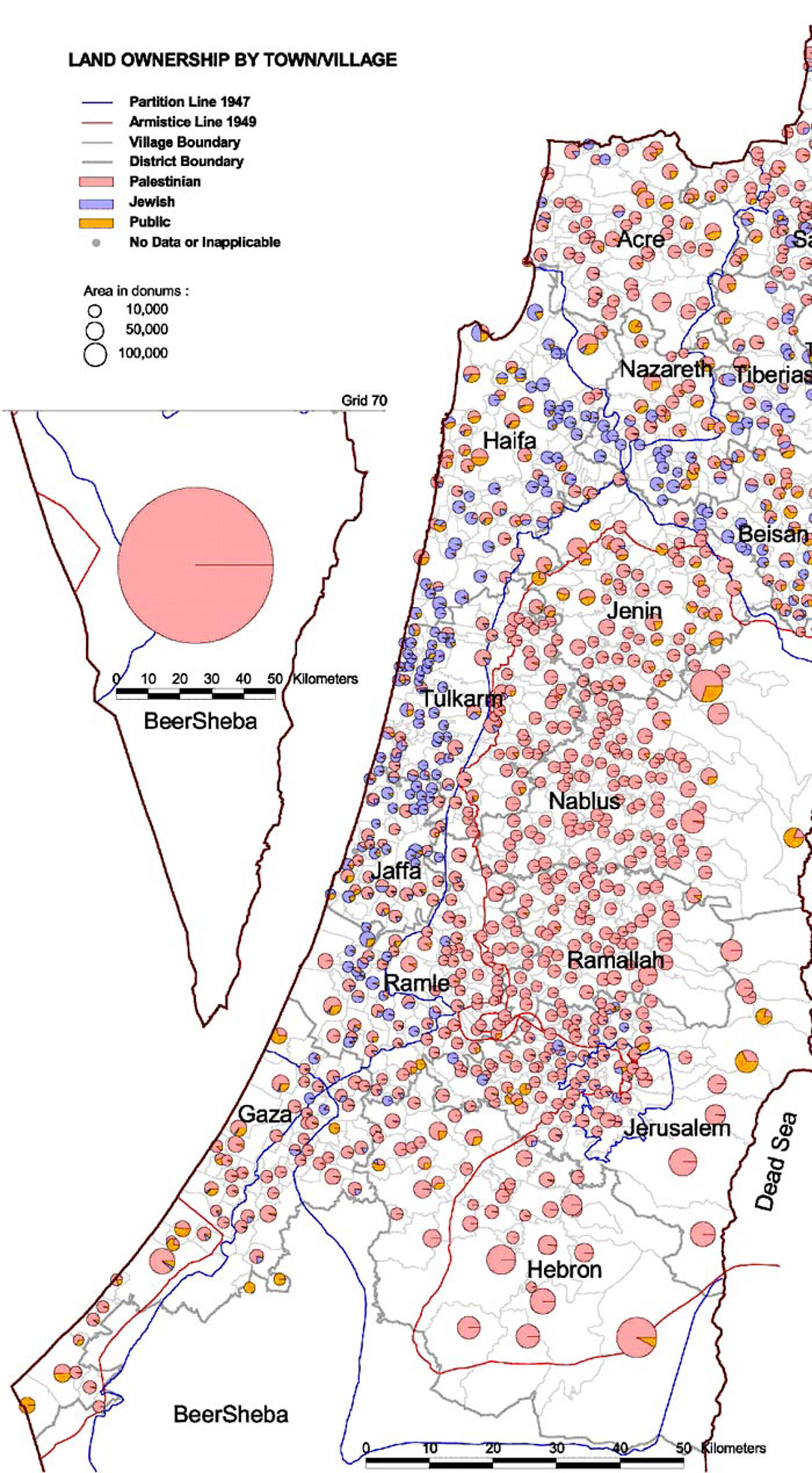You know which one Einstein was referring to.
Back to the maps. There is no consistency in the four maps.
Highly contested opinion if you read on the extensive commentary against McGraw-Hill. Renowned cartographers also support the four maps as an informative illustration on land possession.
The first map inaccurately compares Jewish owned land with non-Jewish owned land and assumes all non-Jewish owned land is Palestinian owned, whereas the reality was that much of the land was owned by absentee landlords from Cairo, Damascus and Istanbul and large areas of the Negev desert weren’t owned by anyone.
A few points here since you brought up absentee landlords. The whole region of Israel and Gaza, West Bank amount to 28,092 km2. From and up to 1944, Israeli has bought a total of 906.80 km2 of land. Of these, 25% were sold by Palestine Arabs, and 52% were sold under the nuance of absentee landlords. Two things:
1. The fact that 25% of the land bought were Palestinian owned imply that Palestinians do own a sizeable portion of the land area. In fact, the United Nations Conciliation Commissions for Palestine has a record of not less than 530,000 land ownership records owned by Palestinians. Here is a detailed map of land ownership in Palestine.

2. Despite the ownership being recorded by UNCCP, I feel you may still want to argue that the 52% non Palestinian owned land were owned by absentee landlords. Now, The absentee landlords lands were not bought but rather appropriated in a clever way that, playing devil's advocate, because there is a lack of documentation recorded by UNCCP, the land is declared owned by an 'absentee landlord'. A special hearing was made in 1930s by MK Tichon, Orok and several other MKs questioning how land is concluded as having an absentee landlord. The inquest found that because the land was not declared, the mukhtar of the town/village, in exchange for money, can produce an affidavit out of thin air that the land can be bought from the mukhtar based on it being owned by an 'absentee landlord'. As how you allude to the idea that Negev desert was not owned by anyone, these lands were actually not owned by any absentee landlord, but rather either owned by a Palestinian who was oblivious his land was being sold by the mukhtar, or have no ownership thus making those who were evicted from these land the landowner in the first place based on the mandate that land with inhabitants cannot be purchased or taken. Adding to this, we also have the absentee landlords who are 'present absentees'. Present absentees are classified as Palestinians who left or were expelled from their land by Israeli forces even for a short duration of time without leaving the Israel boundary, even when the move is involuntary, they lose the legal right to their possession and their land. These Palestinians lands, their Palestinian owners driven away thus classifying them as present absentees, are also land under absentee landlords. So, you see, the usage of the term 'absentee landlord' was a convenient loophole to allow for the appropriation of land.
And on Negev, The Negev desert may not be documentedly owned by anyone, as title deeds are not compulsory registered and claims of ownership were regulated by private unregistered conveyances, but an official national census conducted on the Negev area listed more than 53,000 Bedu Palestines.
The first map is only inaccurate if you refute firstly the records of land ownership in UNCCP, secondly the revelation of the hearing on how 'absentee landlords' were declared, and thirdly the idea that many parts of the land were not owned by anyone.
The second map reflects a UN plan that was rejected by the Arabs and was never reflected by either land ownership or political control.
See the comment on land ownership above and why it has been rejected. The two state solution however has been revisited by Palestine and preconditional to a 1948 border, with Jerusalem included and the right of return, a compromised two state solution has repeatedly been suggested by Palestinians, regardless of opinions from the Arab league.
The third map reflects political control only and does not reflect anything to do with land ownership as there are still many Arab towns and villages within Israel.
Does this not contradict your argument? If there are
still many Arab towns and villages within Israel, what do you think they were part of in the first place? There are indeed several Arab towns and villages within Israel populated by Arabs who refer themselves as Palestinians.
The final map is an inaccurate representation of the current political control and again does not bear any relationship to land ownership.
By this time, land ownership is no longer the humanitarian concern. What we have in the fourth map is definitely political control whereby failure to comply to stay within the designated Palestinian zones result in being killed. Which is why discussion on land ownership based on the current situation dilutes the more humanistic argument of Palestinians in Gaza crammed in 390km2 of space with more than 5000 people per square kilometre of land when divided equally, making it the 3rd most dense boundary locked area in the world like Hong Kong and Singapore. Unlike the two other countries however, Gaza doesn't have skyscrapers and high rise living, nor does it have clean water, sufficient amenities, enough food, freedom to travel, open ports, employment opportunities and the right to protest.
So basically the maps pick and choose facts to reflect the narrative.
Doesn't mean the facts are wrong or inaccurate. They are after all, recorded and documented throughout the years.

